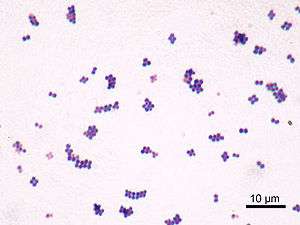Coccus
For the genus of scale insects, see Coccus (insect).
"Cocci" redirects here. For the fungal disease, see Coccidioidomycosis.


Staphylococcus bacteria
A coccus (plural cocci) is any bacterium that has a spherical, ovoid, or generally round shape.[1] It is one of the three distinct bacterial shapes, the other two being bacillus (rod-shaped) and spiral-shaped cells.
Coccus is an English loanword of a modern or neo-Latin noun, which in turn stems from the Greek masculine noun kokkos (κόκκος) meaning "berry".[2]
Arrangements
Cocci may occur as single cells or remain attached following cell division. Those that remain attached can be classified based on cellular arrangement:[1]
- Diplococci are pairs of cocci (e.g. Streptococcus pneumoniae and Neisseria gonorrhoeae)
- Streptococci are chains of cocci (e.g. Streptococcus pyogenes).
- Staphylococci are irregular (grape-like) clusters of cocci (e.g. Staphylococcus aureus).
- Tetrads are clusters of four cocci arranged within the same plane (e.g. Micrococcus sp.).
- Sarcina is a genus of bacteria that are found in cuboidal arrangements of eight cocci.
References
- 1 2 Pommerville, J.C. (2013). Fundamentals of Microbiology (10th ed.). Sudbury, MA: Jones & Bartlett. p. 106. ISBN 9781449647964.
- ↑ κόκκος. Liddell, Henry George; Scott, Robert; A Greek–English Lexicon at the Perseus Project
This article is issued from Wikipedia - version of the 8/29/2016. The text is available under the Creative Commons Attribution/Share Alike but additional terms may apply for the media files.